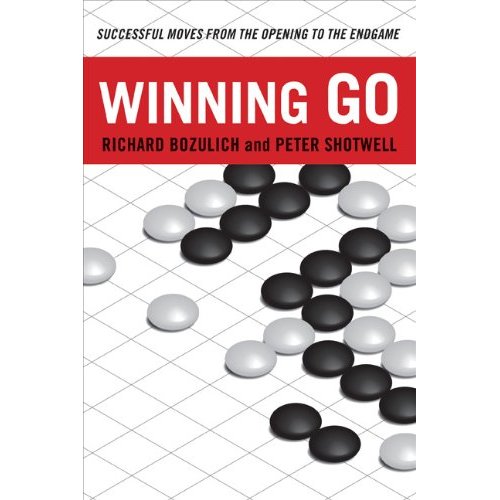Winning Go
BGJ 154 Winter 2010 Reviewer: Glynn Forsythe
ISBN 978-4-8053-1072-4
Subtitled "successful moves from the opening to the endgame" by Richard Bozulich and Peter Shotwell. Published by Tuttle Shokai Inc.

Winning Go is an extremely ambitious book, aiming to cover the entire game from start to finish and showing you the way to first dan. According to Peter Shotwell on the lifein19x19.com forum, it is in fact the book Richard Bozulich wished was available during his own journey to first dan. It will probably be useful to those between 7 kyu and 1 dan.
Topics covered are Katachi - Making Good Shape, Fuseki - The Opening, Tesuji - Clever Moves, Shikatsu - Life and Death, Joseki - Local Skirmishes, Chuban - The Middle Game and Yose - The Endgame. The endgame section is further broken down into counting and endgame tesuji problems.
Rather than having an exhaustive coverage of each topic (which would be impossible in a single volume) each chapter begins with a short discussion of the topic at hand, followed by a selection of problems. The first chapter, Katachi, does not have any problems, but the authors state that good shape is central to each of the later chapters. I found the descriptions at the start of each chapter rather simplistic for my level (1 kyu), but the problems themselves were still challenging. The problems are presented as a block, followed by the answers. Although the problem diagram is repeated before each answer, which would be useful for those capable of doing all of the problems in one go, I found a better solution was using two bookmarks to allow easy flicking forwards and back. Most of the book is filled by the answer sections, which are very detailed. Finally, each chapter has suggestions for further reading with a short description of each book.
Some people may consider the diagrams to be a little small and it has several errors, which make a couple of the problems indecipherable (there are errata for these at senseis.xmp.net). There are some interesting departures from other books available: The fuseki section doesn’t quite start from the beginning of the game, with the earliest diagrams starting from move 12, but instead looks at continuations of the openings. Likewise, the chapter on joseki is not about learning joseki, or choosing the correct one, but rather about getting a feel for the correct continuation and shape.
The point of this book therefore is not to make you into a better go player by itself. It contains many problems (203 in total), but not enough in any one area to really bring you up to 1 dan. Instead it acts more as a guide to the areas in which you are strong, or not so strong, allowing you to better target where you need to improve the most to become a well balanced go player. This is, to my knowledge, a unique premise for an English language go book.
At 256 pages it is quite thick, however readers may not want to pay the full price. Amazon.co.uk has the book listed at a discount.
If you have any comments, please email the webmaster on web-master AT britgo DOT org.
